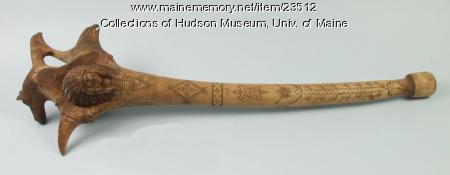
Root club, ca. 1900
Item 105037 info
Maine Historical Society
Wabanaki carvers make clubs from the root bundles of immature gray birch trees. The clubs were historically used as weapons, and indicate the authority of the person carrying it during events, ceremonies, and dances. Historic pieces incorporated carved elements of the natural and spiritual world.

Penobscot root club, Poland Springs, ca. 1900
Item 6650 info
Maine Historical Society
Root clubs are made from the root bundles of immature gray birch trees, and were carried during special events. Carvers continued to make root clubs for Wabanaki communities, and also used their expertise to create a new genre during the late 1800s to early 1900s.
The Victorian tourist market allowed carvers to perpetuate traditional skills, while they explored new motifs and expressions based on a modern reality, influenced by global experiences.
Carvings sometimes morphed to fit market expectations of what “Indian” art looked like, occasionally showing a Native person in iconic Plains-style regalia. This club has moose, birds, a war-bonneted Indian head, and "Poland Spring, Me." carved on it.

Penobscot rootclub, Port Clyde, ca. 1900
Item 23482 info
Hudson Museum, Univ. of Maine
M. R. Sabatis and J. Susep carved for the novelty goods trade. Their names and "Port Clyde, Maine" are inscribed on it.

Miniature rootclub, ca. 1850
Item 23480 info
Hudson Museum, Univ. of Maine
Found under the floorboards in a structure connecting a house and barn in the town of Penobscot, this may have been a shaman's ceremonial club.
It represents an early style of rootclub in which the wood was stained, not painted.

Penobscot rootclub by Russell Joe, Indian Island, ca. 1930
Item 23481 info
Hudson Museum, Univ. of Maine
This club is attributed to Penobscot carver Russell Joe (Granton Russell Joseph), who lived from the early 1900s to the mid 1960s on Indian Island.
Russell Joe carved rootclubs, walking sticks and tomahawks and sold them to visitors.

Penobscot rootclub by Stanley Neptune, Indian Island, 1996
Item 23512 info
Hudson Museum, Univ. of Maine
Stanley Neptune, who made this rootclub, learned to carve from Senabeh (Roland Francis).
This club reflects design motifs that were common to the work of his teacher, including the floral chip carving on the club's stock.
Neptune signs his work with an eel, his family's clan symbol.

Penobscot rootclub, ca. 1910
Item 23483 info
Hudson Museum, Univ. of Maine
This Native American rootclub was acquired on Mount Desert Island.

Spirit face rootclub, ca. 1900
Item 23478 info
Hudson Museum, Univ. of Maine
Rootclubs, carved by Native Peoples, first were used as weapons, then became emblems of power and authority.
Rootclubs now are art forms. The spirit face suggests that this club was intended for spiritual or ceremonial purposes.
This slideshow contains 8 items

